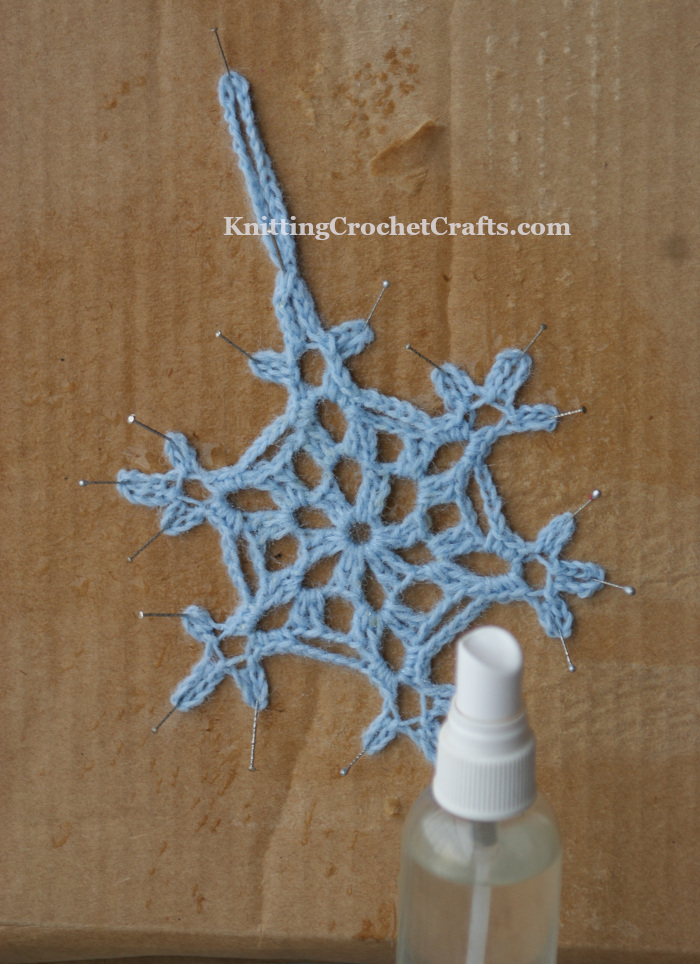In this guide to blocking, you will learn how to block your knitting and crochet projects to make them look their best.

How to Block a Crocheted Snowflake: Pin the Snowflake to Cardboard and Wet It; Then Allow It to Air Dry.
What Is Blocking? What Does It Mean to Block Your Knitting Projects or Crochet Projects?
There are many different finishing techniques you can use to enhance your knitting and crochet projects. Blocking is one of these finishing techniques. You’d want to block your pieces if those pieces would benefit from slight adjustments in shape or dimensions.
I recommend blocking any projects you make using natural fiber yarns that respond well to this technique; I do not recommend blocking projects made using synthetic yarn (we’ll get into the reasons for that recommendation momentarily).
Why Block Your Knitting or Crochet Projects? What Are the Benefits of Blocking Knitting and Crochet?
Blocking will help your knitting and crochet projects to look their best. It can make a huge improvement in how they look.
If you’ve knitted or crocheted a garment that has two identical pieces — for example, a sweater that has two sleeves, it’s ideal to block the sleeves to the exact same measurements and dimensions; you’d also want to block the body of the sweater, paying careful attention to block the armholes to exactly the right dimensions, too.
If you’ve knitted or crocheted a lace item, slightly stretching the lace when you block the item will help to define the lace pattern and make it look as impressive as possible.
Blocking can often enhance the drape of a finished needlework project. If you aren’t happy with how a finished poncho, shawl or scarf is draping, try stretching it slightly when you block it to see if that could improve the project’s drape and flow.
Do All Crocheted and Knitted Pieces Need Blocking?
Crocheted and knitted pieces do not all need to be blocked, but it’s usually beneficial to block all your lace knitted or crochet lace projects. It’s also advantageous to block your hand-knitted socks and other pairs of items to be the same exact size and shape.
At What Stage of the Project Do You Block It?
Blocking is typically one of the final stages in the project. If you’ve made a project that has multiple pieces, like a sweater or granny square blanket, you block the pieces before joining them. If you made a project that’s a single piece or pair of single pieces, like a scarf or a pair of socks, blocking will be the final stage of the project.
Blocking Methods for Crochet and Knitting
There are several different ways you can approach the task of blocking your knitting or crochet projects. You could use sock blockers to block socks; a blocking board or flat piece of cardboard; towels; rustproof pins; blocking wires; a steam iron; a steamer; and / or a spray bottle.
Wet Blocking Knitting or Crochet Projects:
If you’ve knitted or crocheted a project using colorfast fibers that can safely get wet, wet blocking is a viable option. Check your yarn label before proceeding to make sure dry cleaning is not the recommended method of care.
To wet block your project, dampen your project by spritzing it with water using a spray bottle. An alternative is to submerge the project in cool water; you can do this in a bucket, your sink or your bathtub, depending on the project’s size.
Shape or gently stretch the moistened fabric into the shape you want it and pin it into position on a blocking board, ironing board, or piece of cardboard using rustproof pins. Alternatively, you can use sock blockers for socks or blocking wires for shaping large pieces with straight edges — for example, sweater pieces or baby blankets.
The project should be placed in a spot where it can remain undisturbed until it has been allowed to completely air dry.
Steam Blocking Knitting or Crochet Projects
To steam block your knitting or crochet projects, you’ll need either a steam iron or steamer.
If you use a steam iron, fill the iron with water as directed and use the hottest steam setting that’s recommended given the fiber contents of your project. DO NOT allow the hot surface of the steam iron to come into direct contact with your project. Instead, hold the hot steam iron a few inches away from the fabric.
Please, for your own health and safety, do not steam block projects made from synthetic fibers such as acrylic. People do use this method for blocking their acrylic projects, but it works because the method melts the fibers slightly. It is very dangerous to heat synthetic yarns to the point that they melt because synthetic yarns and the chemicals they are finished with might outgas or emit toxic vapors when you subject them to this level of heat or humidity. Although this method technically works for blocking acrylic projects, it is not particularly safe or healthy to do it.
So there you have it: That’s your guide to blocking knitting and crochet projects. I hope you found this information helpful. If you have questions or comments, you’re invited to drop a comment in the comments area below. Happy knitting, crocheting, finishing and blocking!
Learn More About How to Finish Your Knitting and Crochet Projects:
References
To learn more about the toxicity of acrylic, check out the following resources:
From the Environmental Protection Agency’s Website: Acrylonitrile Hazard Summary 107-13-1 — IRIS Toxicological Review of Acrylonitrile
From the Agency for Toxic Substances & Disease Registry Toxic Substances Portal: Acrylonitrile
From the Federal Trade Commission’s Website: The rules and regulations under the textile fiber products identification act
J.J. Pizzuto’s Fabric Science
Sixth Edition
Arthur Price
Allen C. Cohen
Fairchild Publications, New York
Copyright 1994
ISBN# 1-56367-004-6
Textiles: Fiber to Fabric
Fifth Edition
Dr. Bernard P. Corbman
McGraw-Hill Book Company
Copyright 1975
ISBN# 0-07-013125-2
Posted By: Amy Solovay
This page was last updated on 11-13-2023.